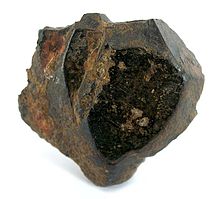| Ilmenite | |
|---|---|
 Ilmenite from Miass, Ilmen Mts, Chelyabinsk Oblast', Southern Urals, Urals Region, Russia. 4.5 x 4.3 x 1.5 cm | |
| General | |
| Category | Oxide mineral |
| Formula (repeating unit) | Iron titanium oxide, FeTiO 3 |
| IMA symbol | Ilm[1] |
| Strunz classification | 4.CB.05 |
| Dana classification | 04.03.05.01 |
| Crystal system | Trigonal |
| Crystal class | Rhombohedral (3) H-M symbol: (3) |
| Space group | R3 (no. 148) |
| Unit cell | a = 5.08854(7) c = 14.0924(3) [Å]: Z = 6 |
| Identification | |
| Color | Iron-black; gray with a brownish tint in reflected light |
| Crystal habit | Granular to massive and lamellar exsolutions in hematite or magnetite |
| Twinning | {0001} simple, {1011} lamellar |
| Cleavage | Absent; parting on {0001} and {1011} |
| Fracture | Conchoidal to subconchoidal |
| Tenacity | Brittle |
| Mohs scale hardness | 5–6 |
| Luster | Metallic to submetallic |
| Streak | Black |
| Diaphaneity | Opaque |
| Specific gravity | 4.70–4.79 |
| Optical properties | Uniaxial (–) |
| Birefringence | Strong; O: pinkish brown, E: dark brown (bireflectance) |
| Other characteristics | Weakly magnetic |
| References | [2][3][4] |
Ilmenite is a titanium-iron oxide mineral with the idealized formula FeTiO
3. It is a weakly magnetic black or steel-gray solid. Ilmenite is the most important ore of titanium[5] and the main source of titanium dioxide, which is used in paints, printing inks,[6] fabrics, plastics, paper, sunscreen, food and cosmetics.[7]
- ^ Warr, L.N. (2021). "IMA–CNMNC approved mineral symbols". Mineralogical Magazine. 85 (3): 291–320. Bibcode:2021MinM...85..291W. doi:10.1180/mgm.2021.43. S2CID 235729616.
- ^ Barthelmy, David (2014). "Ilmenite Mineral Data". Mineralogy Database. Webmineral.com. Retrieved 12 February 2022.
- ^ Anthony, John W.; Bideaux, Richard A.; Bladh, Kenneth W.; Nichols, Monte C. (eds.). "Ilmenite". Handbook of Mineralogy (PDF). Chantilly, VA, USA: Mineralogical Society of America. Retrieved 12 February 2022.
- ^ ilmenite, Mindat.org
- ^ Heinz Sibum, Volker Günther, Oskar Roidl, Fathi Habashi, Hans Uwe Wolf, "Titanium, Titanium Alloys, and Titanium Compounds" in Ullmann's Encyclopedia of Industrial Chemistry 2005, Wiley-VCH, Weinheim. doi:10.1002/14356007.a27_095
- ^ "Sachtleben RDI-S" (PDF). Archived from the original (PDF) on 25 December 2018. Retrieved 25 December 2018.
- ^ "Products". Mineral Commodities Ltd. Retrieved 8 August 2016.